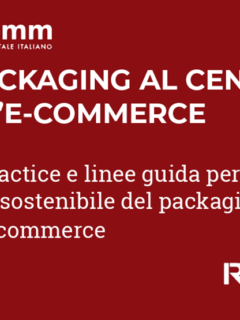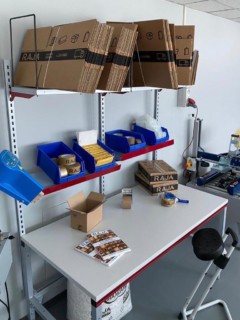Sustainable packaging: a necessary revolution
The ecological transition to increasingly sustainable packaging is no longer an option but a necessity. necessity. The growing awareness of consumers and, consequently, their demand for eco-friendly solutions has prompted companies to rethink their approach to packaging.
In this article we will focus on secondary packaging that is, those used to group together several units of a product, facilitating the transport and handling of products already individually packaged in primary packaging. This type of packaging is fundamental in the distribution chain and serves to protect products during transport and storage.
When packaging is sustainable
Packaging is defined as sustainable when it is produced from recyclable, biodegradable or compostable materials and contributes to reducing the environmental impact of the company using it. Let us now take a look at some innovations related to the food sector, where attention to packaging requires special care.
Refrigerated food transport containers: innovations and sustainability
In the world offood e-commerceone of the main challenges is cold chain management. The aim is to develop sustainable food packaging that is light and robust to minimise the use of raw materials and the impact of transport on the environment while at the same time guaranteeing the freshness and safety of the products.
From polystyrene to paper
Traditional packaging solutions such as polystyrene are often bulky and expensive. In contrast, the paper offers apractical and sustainable alternative. Consider, for example, some products in the RAJA catalogue that offer excellent thermal performance such as:
The importance of mono-material packaging
The trend towardsmonomaterial packaging is driven by the need to simplify the recycling process and reduce material contamination. The adoption of all-paper solutions responds to this emerging market demand, contributing to the creation of a more sustainable product life cycle.
RAJA’s tips for choosing more innovative and sustainable packaging
When it comes to packaging, it is essential to consider efficiency and environmental friendliness. Here are some practical tips for anyone who wants to take a more sustainable approach when choosing packaging:
- Choose recycled and recyclable packaging. Opting for materials that can be reused or recycled is an important step. This choice reduces environmental impact, contributing to a sustainable life cycle for packaging products.
- Focus on functional and environmentally friendly design. Carefully considering packaging design is crucial. Making sure they are efficient in terms of materials and space not only optimises transport and reduces CO2 emissions, but also helps limit waste.
- Evaluate biodegradable options. It is advisable to go for packaging that can naturally degrade at the end of its life cycle. This helps minimise environmental impact and reduce polluting waste.
- Prefer reusable solutions. Adopting packaging solutions that favour reusability can extend product life and reduce the need for new materials.
- Innovate food packaging. It is essential to be scrupulous when choosing food packaging materials. Ensuring that they are food safe and maintain product integrity is critical to consumer health and food quality.
These tips not only represent good practices for those in the packaging industry, but are also useful guidelines for consumers and companies wishing to contribute to a more sustainable future.
We are convinced that l’innovation in packaging can go hand in hand with sustainability. Our goal is to lead the industry towards greener and more responsible solutions, showing that respect for the environment goes hand in hand with efficiency and quality.
The 5 Rs of packaging
RAJA’s commitment to sustainability in packaging can be summarised in the model of the 5 Rs of RAJA. The “5 Rs” represent a set of principles aimed at reduce environmental impact e promote sustainability throughout the packaging life cycle, thereby optimising material consumption.
- Reduce. This principle focuses on reducing the volume and weight of packaging to the minimum necessary to adequately protect the product. It involves avoiding over-packaging and optimising the materials used. Reducing materials not only reduces waste but can also reduce transport costs and CO2 emissions associated with distribution.
- Reuse. The idea is to design packaging that can be used several times before being discarded. This extends the useful life of packaging and reduces the need to produce new ones. Reusable packaging can include sturdy containers, pallets, and shipping boxes.
- Rethink. This concept involves search for innovative and sustainable alternatives to traditional packaging materials and packaging approaches. This may include using biodegradable materials, designing more resource-efficient packaging, or integrating circular economy practices into packaging design.
- Renew. This means using materials from renewable sources for the production of packaging. This may include using paper and cardboard derived from sustainably managed forests, bioplastics from agricultural resources, or other materials based on renewable natural resources.
- Recycling. The aim is to ensure that packaging can be easily recycled at the end of their use. This requires designing packaging that is compatible with existing recycling systems and educating consumers on how to recycle materials correctly.
Beyond materials: innovation and customisation in sustainable packaging
Innovation in packaging is not limited to materials. Take for example the WrapPak Protector paper filling systemwhich uses paper sheets to insulate and maintain temperature during transport. As well as being functional, this solution improves the opening experience for the end customer, combining convenience and attractive design.
The responsibility to adopt sustainable packaging solutions does not only fall on manufacturers; it involves the entire supply chain, including distributors, retailers and consumers. Choose sustainable packaging and practise recycling recycling are crucial steps for a long-term positive impact.














